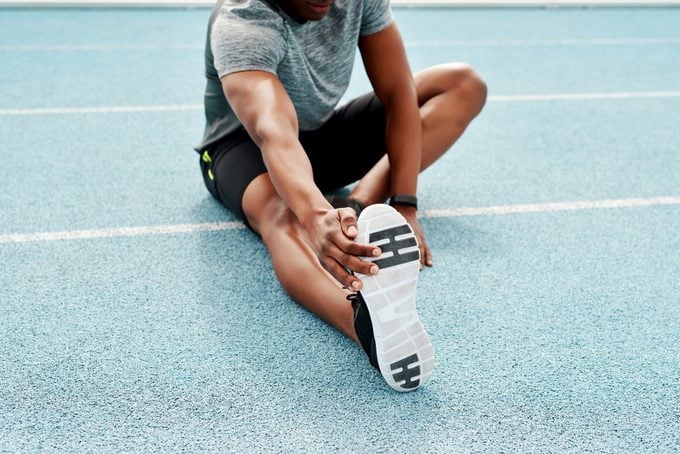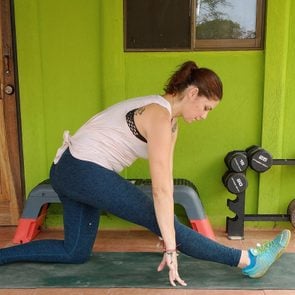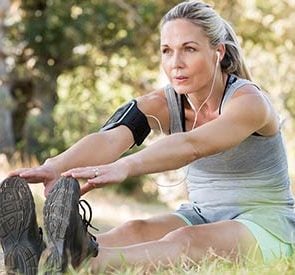9 Benefits of Stretching That Will Convince You to Do It Daily
Updated: Jul. 29, 2022
Why is stretching important? The benefits of stretching include everything from improved flexibility and strength to stress relief.
The importance of stretching
Stretching out stiff and achy muscles after you wake up in the morning or in the middle of the workday is a great way to release tension throughout your body.
And while a lot of people stretch simply because it feels good, there are a ton of other potential benefits of stretching that will encourage you to make this gentle form of movement a regular part of your routine.
“Regular stretching can help you increase your flexibility, which is a key component in your overall health,” says Katelyn DiGiorgio, vice president of training and technique for Pure Barre. “Improving your flexibility will allow you to perform everyday activities, whether small, like picking up a box, or big, like going skiing, with relative ease and with less risk of injury.”
Before we get into the more specific benefits of stretching, here’s a quick refresher on the types of stretching that exist and when it’s best to do each one.
The main types of stretching
According to the American College of Sports Medicine (ACSM), there are four main types of stretching:
-
Static stretching (done actively or passively)
-
Dynamic stretching (often referred to as a dynamic warm-up or cooldown)
-
Proprioceptive neuromuscular facilitation (PNF) stretching
-
Ballistic stretching
PNF stretching is most typically used in training or therapy sessions. So it’s not really something you should do without a trained professional.
And because of the high risk of injury during ballistic stretching, the ACSM doesn’t recommend that people do it as a regular part of their routine.
The other two—static and dynamic stretching—are the main categories we’re talking about when we lay out the benefits of stretching.
Static stretching
“Static stretching is typically done when the body is at rest in a standing, sitting, or lying position,” says DiGiorgio. “The stretch is held for about 15 to 45 seconds in a challenging but attainable position, typically near the end of the range of motion, without movement.”
When you bend down and touch your toes, holding the forward bend for several seconds, you’re doing a static stretch.
A few examples of static stretches:
-
Seated butterfly stretch
-
Seated forward fold hamstring stretch
-
Standing forward fold hamstring stretch
Static stretching usually occurs after a workout as part of the cooldown.
“After exercising, muscles tend to get tight as they cool down,” DiGiorgio says. “Gradually transitioning your body from movement into static stretching will help you ease your muscles into the stretch and ultimately help you gain flexibility and mobility.”
Dynamic stretching
Dynamic stretching involves actively moving your joints and muscles through a full range of motion a few times in a row without stopping.
“Dynamic stretches are functional movements and a great way to get the body warmed up before any type of exercise,” DiGiorgio says.
When trainers talk about warming up before a workout, they’re talking about dynamic stretches that prep your body for the workout to come.
A few examples of dynamic stretches:
-
Lunge with an upper-body rotation
-
Alternate pulling knees to chest
-
Leg swings
-
High knees
The key with dynamic stretching is to do moves that mimic the movements in your upcoming workout, says physical therapist Bianca Beldini, owner of Sundala Wellness in South Nyack, New York. So the dynamic stretches you do before a run will be different than the ones you do before a swim workout.
“The more functional you can make your dynamic stretches, meaning they’re geared towards the activity you’re going to be doing, the better,” Beldini says.
This is also why static stretches don’t really make sense pre-workout. Sports and workouts typically involve movement, not just stretching into one position and holding it for an extended period of time.

What are the benefits of stretching?
Stretching isn’t a magic bullet to get you limber and fit and avoid injury. Many other factors play into your physical well-being.
But there are a lot of potential advantages of stretching that make it worth setting aside five minutes before and after your workout. The nine benefits below are all good reasons to get in a good stretch on the regular.
(Check out these dynamic and static leg stretches.)
It warms up your body for a workout
Doing dynamic stretches pre-workout is a great way to get your blood pumping and warm up your body so that it’s ready to perform during a hard workout.
“Dynamic stretching activates the ability of the tissue to do what you want it to do,” Beldini says. “It gives it a little bit of a nudge and says, ‘This is the activity that you’re about to perform.'”
Warming up also helps your cardiopulmonary system (heart and lungs) ease into things and primes your nervous system for the upcoming stress, she says.
It can improve flexibility
Flexibility is what allows tissues and joints to move comfortably through full ranges of motion.
Research in the International Journal of Sports Physical Therapy suggests that both static stretching and dynamic stretching can effectively improve range of motion.
“Performing proper form in almost any exercise requires mobility and flexibility in the joints and muscles,” she says. But properly doing an exercise isn’t the only reward. A full range of motion will also help you move more effectively in your everyday life (more on that later).
You may feel a little more limber after one stretch session, but improving flexibility is a long game and requires regular stretching multiple times a week.
It may help prevent injury
The research on whether stretching can actually help prevent injuries is murky (and suggests that the answer is highly dependent on the exact activity and type of stretching used).
But many experts, including the ones we spoke to for this piece, do believe that since better flexibility translates to wider ranges of motion and makes it easier to do exercises with proper form, stretching may reduce the risk of injury, even if indirectly.
Think about it this way: if your hamstrings or ankles are so tight that you can’t squat with great form, there’s a better chance you’ll eventually squat with compromised form than if you had more flexible joints and squatted with perfect form every time. And doing an exercise incorrectly ups your chance of injury.
It’s unclear whether simply doing dynamic stretches before a workout will make a noticeable short-term difference or if it requires a long-term regular stretching regimen to notice any actual range of motion results.
It helps strength training
One of the little-known benefits of stretching is better strength.
“People don’t think stretching has anything to do with power or strength, but it absolutely does,” Beldini says.
To tap into a muscle’s full power potential, you need to contract and lengthen the muscle tissue fully. Increasing your range of motion makes it so you can recruit, or use, the entire length of a muscle.
For example, think of a bicep curl. If you can only curl the weight within 10 degrees of motion, because your tissues are too stiff, you’re only going to increase strength within those 10 degrees, Beldini explains.
By not moving through the joint’s full range of motion, you’re losing out on some serious strength gain potential. But with greater range of motion, you’ll be able to curl to a greater degree, increasing strength more.
It makes daily activities feel easier
More pliable connective tissue and muscles make it easier for doing activities of daily living.
“It increases range of motion, which makes it easier to do things like touching your toes or reach up high,” , says Daheia Barr-Anderson, an associate professor in the School of Kinesiology at the University of Minnesota.
This is arguably the most important thing that stretching does for us. And it grows in importance as we age.
Sure, exercise is great for getting stronger and completing impressive workouts or competing in races, but it’s this ability to make everyday life easier that’s one of the most brag-worthy benefits of stretching.
(Give this 10-minute full-body stretching routine a try.)
It improves your sense of bodily awareness
The neuromuscular benefits of dynamic stretching before a workout help foster better bodily awareness, which may also prevent injuries, Beldini says.
Dynamic stretches prime the receptors in the brain that communicate with your body to know where it is in space and help it stay stable, she explains.
Forming this communication pathway between your brain and your body before you get into the nitty-gritty of the workout is a great way to increase the chance that you’ll move with ease and proper form and, ultimately, perform better.
It helps prevent everyday aches and pains
A lot of modern-day aches and pains—lower back pain is a perfect example—happen because we spend so much time being inactive, causing the muscles to get stiff and achy.
“There’s fluid within the joints, and when you stop moving, the fluid does, too, and joints become stiff and tight,” Beldini says.
Stretching and improving flexibility and mobility can boost circulation and keep the joints feeling pliable and less stiff. “Motion is lotion,” Beldini says.
Research in JAMA Internal Medicine suggests that weekly yoga or intensive stretching effectively reduces lower back pain and improves back functioning.
The study looked at 228 adults with chronic low back pain. Ninety-two people took a weekly yoga class, 91 did conventional stretching, and 45 read a self-care book. They found that yoga classes were more effective than self-care books but not better than stretching at improving functioning and reducing symptoms.
Without properly stretching and strengthening, using your lower back muscles all day long—yes, they engage the entire time you sit at your desk—can lead to chronic pain, Barr-Anderson says.
Stretches for lower back pain can help release tension in those areas and alleviate pain.
It helps you cool down after a workout
“Stretching tired and sore muscles after a workout is essential because it enhances flexibility and reduces muscle tension,” DiGiorgio says.
Stretching post-workout isn’t going to stop you from getting sore completely—delayed-onset muscle soreness is from microtears in your muscles, which stretching won’t magically heal—but reducing tension might make you feel less sore overall.
A major benefit of stretching after you work out? “Your muscles are already warm, which will help you ease into the stretches,” DiGiorgio says. It also gives you a chance to slow down gradually.
“Stretching and breathing will help you feel restored and relaxed as opposed to just stopping cold,” DiGiorgio says.
Stopping abruptly can make you lightheaded or even pass out. Cooling down slowly allows your heart rate and body temperature to gradually return to homeostasis, Barr-Anderson says.
It can be really relaxing
“You get the mental benefits of stretching when you add something like deep breathing to it,” Barr-Anderson says. Yoga is the perfect combo of stretching and breathing.
You don’t have to take a formal yoga class to reap the relaxing benefits, though. Pairing slow, controlled, deep breathing with your stretches helps stimulate the parasympathetic nervous system and put you at ease, Barr-Anderson says.
(Here are the best stretching exercises for stress relief.)
How to add stretching to your routine
There’s no prescription for how often to stretch to reap the benefits.
A good place to start is to add two to three minutes of static stretching after a workout, Barr-Anderson says. “You’ll see the benefit and feel it in your body.”
But don’t limit yourself to one type of stretch. Incorporate dynamic stretching into your warm-up. You don’t have to dedicate a whole lot of time to it in order to notice a difference. Most experts recommend a five-minute warm-up to optimally prepare your body and get it ready to move.
If you have a sedentary job, Barr-Anderson suggests stretching throughout the workday as well.
“At least once an hour, take a five-minute break. This could include one minute of gentle stretching and movement, which brings a rush of fresh blood into the system and a sense of renewal,” she says.
Focus on stretching the areas that feel most stiff. If once an hour feels like more than you can squeeze into your schedule, simply allow yourself to stretch just a tad whenever you stand up to use the bathroom or get food. “That will still equate to three to four times a day.”
Barr-Anderson also suggests starting your day with a quick stretch in bed. Bring your knees into your chest when you’re lying down and then stand up and give yourself a big overhead stretch. “That’s one of the best ways you can start your day.”
Now that you know why stretching is important, check out these morning stretches.




